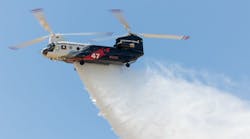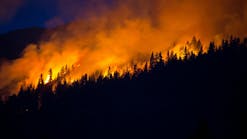Southern California Edison last week filed its annual update to its 2020-2022 Wildfire Mitigation Plan with the California Office of Energy Infrastructure Safety. The 2022 plan has an ambitious mission to continue to strengthen and adapt the grid to withstand extreme weather events likely exacerbated by climate change, including the installation of more insulated wire.
"SCE’s commitment to keep our communities safe remains steadfast, and our plan this year demonstrates the tangible ways that we continue to make the grid safer and more reliable as we better support our customers," said Jill Anderson, SCE executive vice president of Operations. "It includes measures to reduce the frequency and impact of Public Safety Power Shutoffs (PSPS). While we only use PSPS as a last resort during extreme weather conditions, we recognize that these outages are difficult, particularly for frequently impacted communities and our most vulnerable customers."
Continued Work to Strengthen the Grid
SCE began implementing new wildfire mitigation activities in 2018. This latest update reflects the continued progress the company has made in its analytical, engineering and process maturity and incorporates lessons learned from prior years.
Through grid hardening, enhanced inspections, expanded vegetation management and targeted PSPS, along with a suite of other activities the company undertook, SCE estimates that it has reduced the risk of damage from catastrophic wildfires by 65% to 70%, relative to pre-2018 levels. Year over year, the total number of acres burned from wildfires associated with SCE equipment decreased from 128,000 acres in 2020 to less than 500 acres in 2021. This was despite the multi-year drought and extreme wind conditions experienced last year. This improvement could not have occurred without the partnership and dedicated efforts of many leaders throughout the state.
While it can never be fully eliminated, SCE expects to further reduce risk with the work outlined in our 2022 Wildfire Mitigation Plan update and reduce the size and scope of PSPS events. With work completed last year, the company estimates that customers on the most frequently impacted circuits experienced 70% less PSPS outage time based on 2021 weather and fuel conditions.
SCE is updating its grid hardening strategy this year. Covered conductor installation supplemented with inspection and vegetation management continues to be one of the most valuable tools in reducing ignition risk cost effectively and expeditiously. However, SCE is evaluating the expanded use of undergrounding and additional technology solutions for certain locations that pose very high risks based on potential fire spread, burn history, limited egress and extreme wind speeds.
One of the emerging technology pilots that has shown promise in further reducing the risk of ignition is the Rapid Earth Fault Current Limiter (REFCL). REFCL is a technology that detects a power line has fallen to the ground and can almost instantly reduce the energy released to the ground, which resembles the mechanism of a ground fault circuit interrupter in people’s homes.
SCE is also exploring the use of artificial intelligence-based technology to detect wildfires. The program uses satellite imagery in conjunction with SCE’s high-definition camera network and it may alert fire agencies about possible fire starts if the pilot is successful.
Community Outreach and Partnerships
The company will continue to support the resiliency needs of Medical Baseline and Access and Functional Needs (AFN) customers, such as seniors, those with limited English proficiency, those with disabilities and those who face transportation challenges. An example of this is a new battery loan pilot program to support AFN customers who rely on a medical device or assistive technology for independence, health or safety.
Another program that will continue is SCE’s support to bolster aerial fire suppression. Last year, the Los Angeles County Fire Department, Orange County Fire Authority (OCFA), Ventura County Fire Department and other regional agencies partnered with SCE to expand their capabilities with a Quick Reaction Force of the world’s largest fire-suppression helicopters. The Quick Reaction Force consisted of two Coulson-Unical CH-47 helitankers that can each carry up to 3,000 gallons of water or retardant, a Sikorsky-61 that can carry up to 1,000 gallons of water or retardant, a Sikorsky-76 helicopter and a mobile fire retardant base that can actively mix up to 18,000 gallons of fire retardant per hour.
The helitankers function during the day and at night, which typically is the best time to stop wildfires, as winds die down, temperatures ease and humidity rises. Last year, the fleet made 2,192 total drops with 823 of them at night, which amounted to 2.9 million gallons of water and 139,000 gallons of fire retardant.
"As the scope and intensity of wildfire season continue to grow, we are proud to seek out partners that are equally committed to innovating new measures that save lives and protect property," said OCFA Fire Chief Brian Fennessy. "Southern California Edison is such a partner, and our gratitude for their support — from the helitankers of our Quick Reaction Force to fire-resistant poles and a vegetation management program — is matched only by the impact of their actions."
SCE has instituted a formal feedback process to help address specific critiques and recommendations. This includes the company’s engagement effort with communities heavily impacted by PSPS events and actively evaluating and refining stakeholder coordination and customer outreach approaches based on feedback received after past PSPS events.
"Our wildfire mitigation work will increase the reliability and climate resilience of the grid," Anderson said. "These grid upgrades further strengthen a solid foundation for the clean energy transition, supporting the electrification of transportation and buildings needed to meet California’s climate change and air quality goals."
Last year, the implementation of the wildfire mitigation plan cost $1.66 billion and the company expects to spend approximately the same amount this year.


